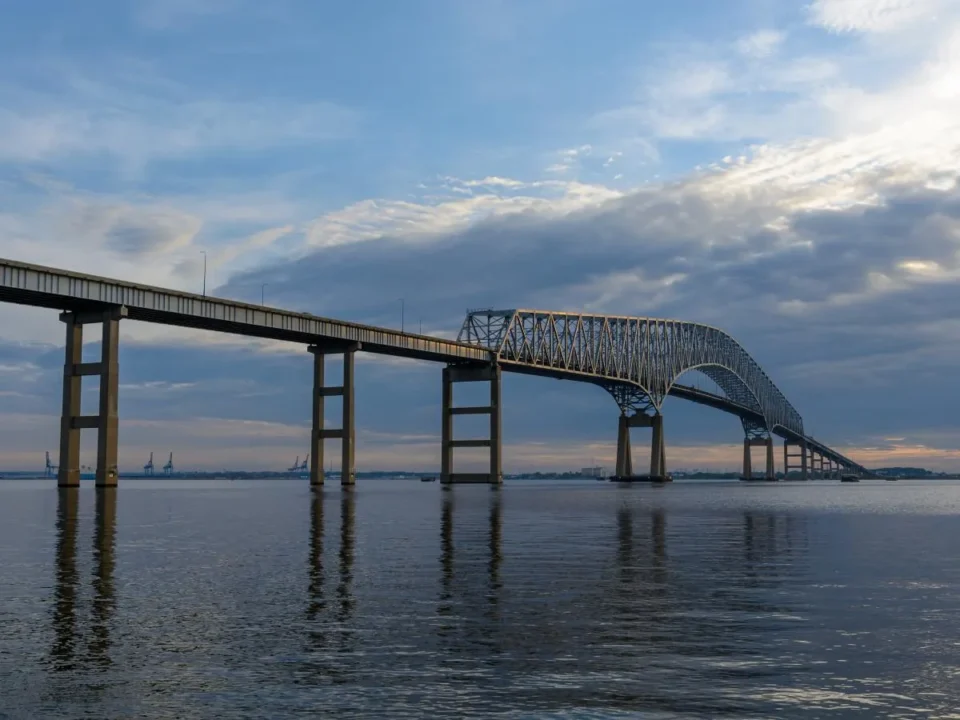The Francis Scott Key Bridge has long been a vital part of Baltimore’s transportation infrastructure. Spanning the lower Patapsco River and the outer Baltimore Harbor, this steel arch continuous through the truss bridge has connected neighborhoods and industries for decades.
However, a recent disaster in 2024 has called attention to the importance of this bridge’s design, leading to plans for its eventual replacement. In this article, we’ll take a look at the history of the bridge, the 2024 collapse, and the plans in place to rebuild it.
History of the Francis Scott Key Bridge

The Francis Scott Key Bridge, opened in 1977, connects Dundalk and Hawkins Point across the Patapsco River. Named after the author of “The Star-Spangled Banner,” it became a key part of Baltimore’s transportation network.
Construction and Design
The Francis Scott Key Bridge was originally envisioned as part of the Outer Harbor Crossing project, aiming to provide a second harbor crossing in Baltimore. Construction began in 1972, with design and construction facing several delays and budget overruns. After years of work, the bridge opened to traffic on March 23, 1977. At the time, it was the second-longest bridge in the Baltimore area, only behind the Chesapeake Bay Bridge. Its main span of 1,200 feet was the third-longest continuous truss in the world.
The Key Bridge’s design utilized a steel arch and continuous truss structure, which allowed for efficient traffic flow and a strong foundation to handle heavy loads. The bridge was vital for shipping traffic, especially for those carrying hazardous materials prohibited in tunnels.
Renaming to Honor Francis Scott Key
In 1976, the bridge was renamed to honor Francis Scott Key, the author of “The Star-Spangled Banner,” a poem inspired by his experience watching the Battle of Baltimore in 1814. Key’s connection to the area, particularly his role in history and proximity to the location of the bridge, made this tribute fitting. This name change highlighted the cultural and historical significance of the structure, further cementing the bridge’s importance to the Baltimore community.
Operational Impact
The Bridge’s Role in Baltimore’s Transportation System
As a crucial link in the Baltimore Beltway (I-695), the Francis Scott Key Bridge carried an estimated 11.5 million vehicles annually. It served as an essential route for both commuters and freight, including trucks carrying hazardous materials that were prohibited from using other tunnels in the region.
The bridge’s location on the outer edge of the Beltway allowed it to complete the last gap in I-695’s circuit around the city, offering vital connectivity. In addition to its role in road transportation, the Key Bridge was an important part of the region’s industrial operations, ensuring efficient access to the Port of Baltimore and nearby areas.
Traffic and Tolls
Opened with four lanes of traffic, the bridge was designed to accommodate a high volume of vehicles. The tolling system for the Key Bridge has evolved. Initially, drivers paid a cash toll, but as technology advanced, the system transitioned to electronic tolling, eventually becoming fully cashless in 2019. The introduction of E-ZPass lanes in both directions allowed for faster traffic flow, reducing congestion and delays for travelers.
The tolls varied over the years but remained a consistent source of revenue for the Maryland Transportation Authority (MDTA), which managed the bridge.
Recognition and Awards
The Francis Scott Key Bridge has been recognized for its engineering and design. In 1978, it received the Award of Merit from the American Institute of Steel Construction in the Long Span category. This recognition helped highlight the bridge as an important part of Baltimore’s infrastructure, not just for its functionality but also for its architectural design.
The 2024 Collapse

On March 26, 2024, tragedy struck when the container ship MV Dali collided with the southwest supporting pier of the Francis Scott Key Bridge. The ship, which had lost power, caused a catastrophic collapse of the bridge’s main spans. At 1:28 a.m., the steel truss collapsed, sending wreckage into the Patapsco River and halting all shipping traffic to and from the Port of Baltimore.
The collapse led to widespread disruption in shipping, with immediate economic losses estimated at $15 million a day. Fortunately, a mayday distress call from the ship’s crew allowed authorities to halt traffic on the bridge before the collapse, preventing further fatalities. However, six maintenance workers on the bridge lost their lives, and others were injured.
Casualties and Damage
The collapse had severe consequences, including the loss of lives and significant disruption to Baltimore’s shipping industry. The Port of Baltimore, one of the busiest ports on the East Coast, was rendered nearly inaccessible for a period, which further compounded the financial losses. The damage to the bridge itself was catastrophic, with large portions of the superstructure resting on the vessel’s bow.
Efforts to remove the wreckage began almost immediately, but the operation was slow and complicated due to the massive scale of the collapse and the dangerous conditions caused by the wreckage in the water.
What dinosaur has 500 teeth? Check it out here to learn more.
The Aftermath and Replacement Plans

In the aftermath of the collapse, Maryland officials, along with federal support, announced plans to rebuild the bridge. President Joe Biden declared that the federal government would fund the full reconstruction of the bridge. Maryland’s Department of Transportation (MDOT) aims to complete the project by 2028, with an estimated cost ranging from $1.7 billion to $1.9 billion.
The new design will feature redundant support structures to prevent a similar disaster from occurring in the future. The bridge will be built to accommodate current traffic demands and improve the safety and reliability of the region’s transportation network.
Ongoing Work and Challenges
While the new bridge will be a major undertaking, temporary measures have been put in place to ease the disruption caused by the collapse. Several shipping channels were opened to allow for partial access to the Port of Baltimore, and large ships were redirected, increasing reliance on air cargo solutions like the atlas air boeing 747 until a permanent solution could be implemented.
Construction work on the new bridge is expected to begin in early 2025. The contract for the new bridge was awarded to Kiewit Corporation, which will manage the rebuilding process. The project is projected to take several years, with work continuing until at least 2028.
Impact on Baltimore’s Transportation Network
The reconstruction of the Francis Scott Key Bridge will significantly impact local traffic, with detours and changes in the Beltway’s route affecting commuters. However, once completed, the bridge will ensure that Baltimore maintains its critical transportation connections, particularly for hazardous materials and shipping operations.
As the city navigates the rebuilding process, the importance of maintaining resilient infrastructure has become even more apparent. The new Key Bridge will offer greater safety, improved design, and a more reliable transportation route for generations to come.
Catherine the Great furniture is a topic that might be of interest to explore further for those with a penchant for history and design.
Looking Ahead: What’s Next for the Key Bridge?

The new Francis Scott Key Bridge will incorporate modern engineering techniques, including more robust support structures and materials that will improve its resilience. These changes will help future-proof the bridge against similar disasters, ensuring that it remains a vital part of Baltimore’s infrastructure for decades.
The Future of Transportation in Baltimore
The replacement of the Key Bridge will not only provide better transportation connections but will also be a symbol of the region’s commitment to rebuilding and improving its infrastructure. Once complete, the new bridge will play a vital role in supporting the growing demands of Baltimore’s traffic and shipping industries.
Public Engagement and Community Impact
Throughout the rebuilding process, community members and businesses will have opportunities to stay informed about progress and provide input on the project. This will help ensure that the new bridge meets the needs of Baltimore’s residents and industries, contributing to the city’s long-term prosperity.
Mary Marquardt is an intriguing historical figure worth learning about.
The Francis Scott Key Bridge has faced many challenges over the years, from its construction delays to the recent collapse in 2024. However, the plans in place for its replacement offer hope for a stronger, safer, and more resilient infrastructure for Baltimore’s future. As work begins in 2025, the rebuilding of the Key Bridge will be a milestone in the city’s efforts to strengthen its transportation network.For more details on how infrastructure projects like the Key Bridge’s replacement will impact the future of Baltimore and beyond, visit https://plantsumo.com.





